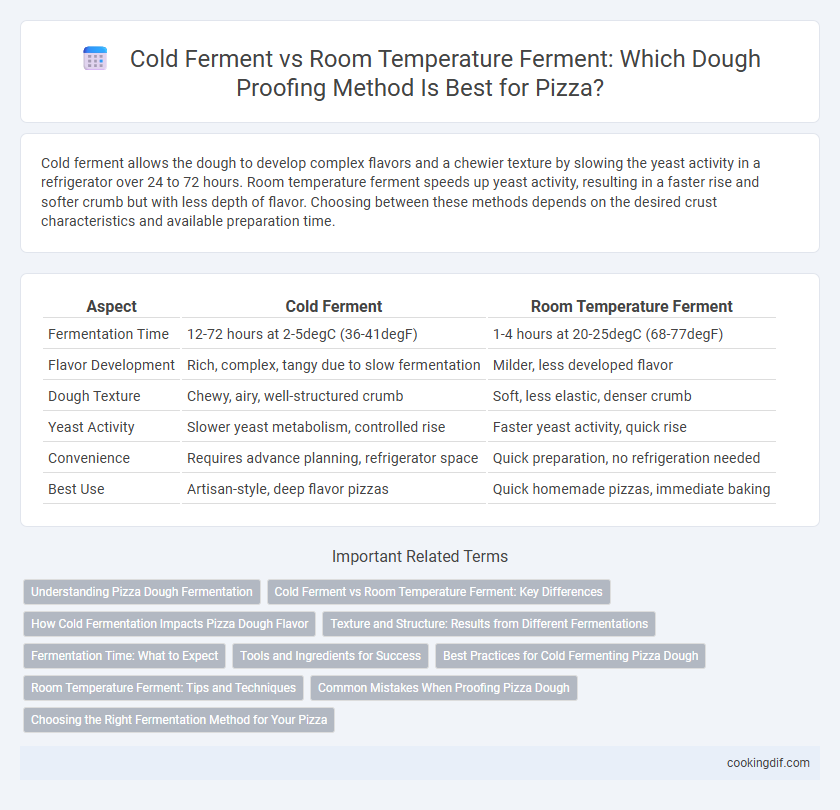Cold ferment allows the dough to develop complex flavors and a chewier texture by slowing the yeast activity in a refrigerator over 24 to 72 hours. Room temperature ferment speeds up yeast activity, resulting in a faster rise and softer crumb but with less depth of flavor. Choosing between these methods depends on the desired crust characteristics and available preparation time.
Table of Comparison
| Aspect | Cold Ferment | Room Temperature Ferment |
|---|---|---|
| Fermentation Time | 12-72 hours at 2-5degC (36-41degF) | 1-4 hours at 20-25degC (68-77degF) |
| Flavor Development | Rich, complex, tangy due to slow fermentation | Milder, less developed flavor |
| Dough Texture | Chewy, airy, well-structured crumb | Soft, less elastic, denser crumb |
| Yeast Activity | Slower yeast metabolism, controlled rise | Faster yeast activity, quick rise |
| Convenience | Requires advance planning, refrigerator space | Quick preparation, no refrigeration needed |
| Best Use | Artisan-style, deep flavor pizzas | Quick homemade pizzas, immediate baking |
Understanding Pizza Dough Fermentation
Cold ferment enhances pizza dough flavor through a slow yeast activity process occurring at temperatures between 35degF and 45degF over 24 to 72 hours, allowing complex organic acids and alcohols to develop. Room temperature fermenting accelerates yeast activation at approximately 70degF to 75degF, typically completing proofing within 1 to 3 hours, which produces a lighter texture with less pronounced flavor depth. Understanding the impact of fermentation temperature on gluten development, yeast metabolism, and flavor compounds is crucial for optimizing pizza dough texture and taste.
Cold Ferment vs Room Temperature Ferment: Key Differences
Cold ferment dough undergoes a slow, controlled rise in the refrigerator for 24 to 72 hours, developing complex flavors and a chewier texture due to extended yeast activity. Room temperature fermenting takes place over a shorter period, typically 1 to 3 hours, resulting in a quicker rise and a lighter, airier crust but less depth of flavor. Choosing cold ferment enhances dough extensibility and crust crispiness, while room temperature ferment is ideal for faster preparation and softer crusts.
How Cold Fermentation Impacts Pizza Dough Flavor
Cold fermentation enhances pizza dough flavor by allowing yeast to slowly break down starches and proteins over 24 to 72 hours, producing complex organic acids and alcohols that deepen the taste profile. This extended process increases the dough's aromatic compounds, resulting in a tangier, more nuanced crust compared to room temperature fermentation. The lower temperature also controls yeast activity, preventing overproofing and promoting a chewier texture with improved crust browning during baking.
Texture and Structure: Results from Different Fermentations
Cold ferment enhances dough texture by slowing yeast activity, resulting in a more developed gluten network and chewier crust, while room temperature ferment speeds fermentation, producing a softer, airier crumb with larger gas bubbles. Cold fermentation promotes complex flavor development and a denser structure, ideal for crispier pizzas, whereas room temperature proofing yields a lighter texture with less pronounced flavor complexity. Choosing fermentation temperature directly impacts dough elasticity, crust crunchiness, and overall pizza texture.
Fermentation Time: What to Expect
Cold fermenting pizza dough slows down yeast activity, allowing fermentation to extend up to 72 hours, which enhances flavor complexity and gluten development. Room temperature ferment drastically shortens fermentation time to 1-3 hours, producing a softer dough with less pronounced tanginess. Choosing between cold and room temperature ferment depends on desired dough characteristics and scheduling flexibility.
Tools and Ingredients for Success
Cold ferment requires a precise temperature-controlled environment, typically between 38degF to 45degF, using a refrigerator to slow yeast activity and develop complex flavors over 24 to 72 hours. Room temperature ferment relies on kitchen ambient temperatures around 70degF to 75degF, needing a warm, draft-free spot and often a proofing box or covered bowl to maintain humidity and ensure consistent yeast activation. High-quality flour with strong gluten content and balanced yeast amounts are essential in both methods, while hydration levels and salt must be carefully measured to optimize dough elasticity and taste.
Best Practices for Cold Fermenting Pizza Dough
Cold fermenting pizza dough at temperatures between 37degF and 42degF (3degC-6degC) enhances gluten development and allows complex flavor profiles to develop over 24 to 72 hours. Maintaining consistent refrigeration slows yeast activity, producing a chewier crust with better texture and increased digestibility compared to room temperature fermentation. Best practices include using airtight containers to prevent drying, monitoring dough hydration levels around 60-65%, and allowing dough to reach room temperature before shaping to optimize elasticity and oven spring.
Room Temperature Ferment: Tips and Techniques
Room temperature fermenting dough typically takes 4 to 6 hours, allowing yeast to activate more quickly and produce a light, airy crust with balanced flavor. Maintaining a consistent ambient temperature between 70degF to 75degF (21degC to 24degC) optimizes yeast activity and gluten development, resulting in better oven spring and texture. Covering the dough with a damp cloth or plastic wrap prevents drying out, ensuring smooth fermentation and ideal dough elasticity for baking.
Common Mistakes When Proofing Pizza Dough
Common mistakes when proofing pizza dough include using room temperature fermentation without controlling humidity, which can cause uneven yeast activity and dough drying out. Cold fermenting in the refrigerator allows for slower yeast development, resulting in better flavor and texture but requires precise timing to avoid over-proofing. Ignoring temperature and proofing duration can lead to dough that is either under-proofed and dense or over-proofed and overly sticky.
Choosing the Right Fermentation Method for Your Pizza
Cold fermentation enhances dough flavor and texture by allowing slow yeast activity at temperatures between 35-45degF over 24-72 hours, resulting in a chewier crust with complex aromas ideal for Neapolitan and artisanal styles. Room temperature fermentation, typically occurring at 70-75degF for 1-4 hours, accelerates yeast activation for faster proofing, producing lighter and airier pizza bases suited for quick preparation and thin-crust recipes. Selecting the right method depends on desired crust characteristics, time availability, and recipe requirements, balancing flavor development with proofing speed.
Cold ferment vs Room temperature ferment for dough proofing Infographic

 cookingdif.com
cookingdif.com